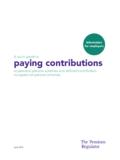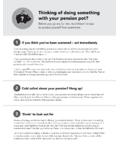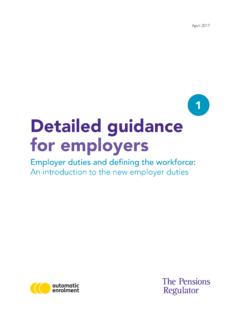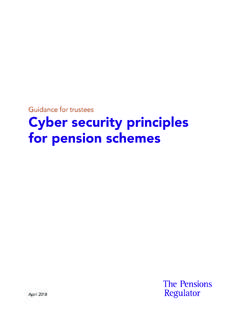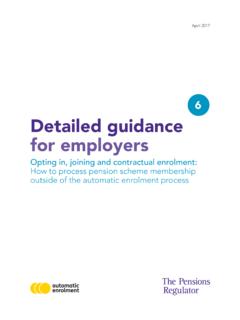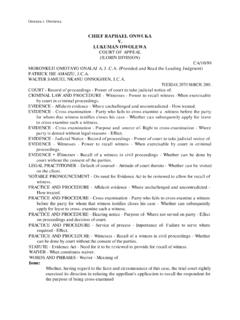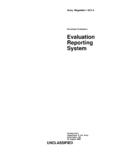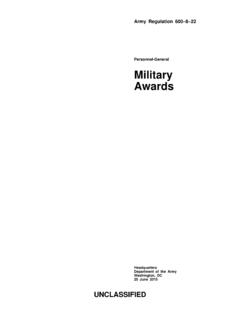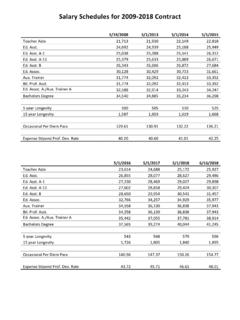Transcription of 2 Detailed guidance for employers - The Pensions …
1 April 2017 Getting ready: First steps to prepare for the new employer dutiesDetailed guidance for employers2 Detailed guidance for employers no. 2 Getting ready2 Automatic re-enrolment1233a3b3c4567891011 Publications in the seriesEmployer duties and defining the workforce An introduction to the new employer dutiesGetting ready First steps to prepare for the new employer dutiesAssessing the workforce How to identify the different categories of workerPostponementTransitional period for schemes with defined benefitsHaving completed the assessmentPension schemes Pension schemes under the new employer dutiesAutomatic enrolment An explanation of the automatic enrolment processOpting in, joining and contractual enrolment How to process pension scheme membership outside of the automatic enrolment processOpting out How to process opt-outs from workers who want to leave a pension schemeSafeguarding individuals The new safeguards for workersKeeping records Records that must be kept by law under the new employer dutiesInformation to workersDetailed guidance for employers no.
2 2 Getting ready3 Publications in the seriesAccompanying resourcesInformation to workers Summary of information requirements in a quick-reference table formatThe different types of worker Diagram of the different categories of worker and the criteria for each categoryEmployer duties and safeguards At-a-glance summary of the duties and safeguardsDetailed guidance for employers no. 2 Getting ready4 Contents About this guidance 5 Introduction 6 Section 1: employers with a staging date 7 Identifying the staging date 8 Deciding whether to use postponement at staging 16 Making an initial assessment of the workforce 17 The pension scheme for automatic enrolment 19 Getting information ready 22 Setting up payroll 24 Getting ready to manage opt-outs 26 Getting ready to manage opt-ins 26 Assessing the impact on business processes 26 Record-keeping 27 Make a formal assessment of the workforce 28 Section 2.
3 New employers from 2 April 2017 with immediate duties start dates 29 Introduction 30 Understanding the duties start date 31 Making an initial assessment of the workforce 34 The pension scheme for automatic enrolment 34 Getting information ready 37 Setting up payroll 39 Deciding whether to use postponement at the duties start date 40 Getting ready to manage opt ins or requests to join 40 Record-keeping 41 Making a formal assessment of the workforce 41 Employing a worker for the first time on or after 2 April 2017 41 and 30 September 2017 and the duties start dateWhat next? 46 Changes from last version 47 Key terms: Summary of the different categories of worker 48pageDetailed guidance for employers no.
4 2 Getting ready5 About this guidanceThis guidance is aimed at professionals and employers with in-house Pensions employer reading this guidance should note that it provides a summary of the main steps in getting ready and that much of the detail about the requirements is contained in our other guidance . These will be signposted in this document where relevant. This guidance is particularly relevant to employers setting up a pension for the first recognise that many employers will already have a pension for their workers, and that this will often match or exceed the minimum requirements contained in the duties. In these cases, such employers may just need to check that the minimum requirements are covered in their existing will be helpful to employers to be familiar with the different categories of workers. These are explained in detail in Detailed guidance no.
5 1 Employer duties and defining the workforce. A quick reminder is also available in the Key guidance forms part of the latest version of the Detailed guidance for employers (published April 2017). It has been updated to include guidance for new employers after the end of the staging period. This has resulted in the guidance being split into two sections: Section 1 is for employers with a staging date. Section 2 is for the new employers whose duties start immediately. As a result, paragraph numbers have changed. The section Changes from last version has a list of these guidance is a reference point for the preparationsDetailed guidance for employers no. 2 Getting ready6 Introduction1. The law on the employer duties and safeguards commenced in July 2012. One of these duties places a requirement on employers to automatically enrol certain workers into a pension scheme.
6 There are other duties as well as automatic enrolment, including the provision of certain information to their An employer is anyone who has entered into a contract with an individual that falls within the definition of worker . For more information on the definition of worker see Detailed guidance Employer duties and defining the Each employer already in existence on 1 April 2012 was allocated a date from when the new duties will apply to them, known as their staging date . An employer who first pays PAYE income1 to a worker on or after 1 April 2012 up to and including 30 September 2017 is also allocated a staging date (excluding an employer who first pays PAYE income on or after 2 April 2017 up to and including 30 September 2017 and who does not have a PAYE scheme).4. An employer in existence on or before 1 April 2012 but who does not have a PAYE scheme, or an employer created between 1 April 2012 up to and including 1 April 2017 who does not have a PAYE scheme, has a staging date of 1 April 2017.
7 5. An employer in existence on 1 April 2017 who does not fall into any of the groups described in paragraphs 3 and 4 also has a staging date of 1 April Staging dates started from October 2012 and end on 1 February 2018. For an employer who has a staging date, the employer duties will usually apply to them from a date that is some time after they became an employer. As such, there are steps they can take in advance of their staging date to get ready for the start of the An employer who employs their first worker on or after 2 April 2017 will, in most cases, have the duties apply immediately they become an employer. They will need to be ready for automatic enrolment as soon as they take on their first worker. These employers are include: An employer who becomes an employer on or after 2 April 2017 and does not have a PAYE scheme, irrespective of whether they pay PAYE income or not.
8 (This includes an employers who first pays PAYE income on or after 2 April 2017 in respect of any worker up to and including 30 September 2017 and does not have a PAYE scheme.) An employer who first pays PAYE income in respect of any worker on or after 1 October 2017. It is an employer s responsibility to identify their staging date1 In our view PAYE income is total earnings in employment (salary, wage, fee etc) whether that amount is above or below the income tax threshold or the lower earnings limit for national guidance for employers no. 2 Getting ready7 Section 1: employers with a staging date This guidance is divided into two sections. If the employer is one who falls into one of the different groups of employers in paragraph 3 to 5, they should read section 1 for further information about preparing for the introduction of the employer duties.
9 If the employer is one who falls within paragraph 7, section 2 contains further information about new employers with immediate 1: employers with a staging date9. This section of the guidance is relevant to: An employer already in existence on 1 April 2012 An employer who first pays PAYE income to any worker on or after 1 April 2012 up to and including 30 September 2017 (but not an employer who first pays PAYE income on or after 2 April 2017 up to and including 30 September 2017 who does not have a PAYE scheme (see section 2)) An employer in existence on or before 1 April 2012, but who does not have a PAYE scheme, or an employer created between 1 April 2012 and 1 April 2017 who does not have a PAYE scheme An employer in existence on 1 April 2017 who does not fall into any of the groups described in the bullets This section provides further information about what steps an employer can take to prepare for the introduction of the new duties before their staging An employer s first step in getting ready is finding out their staging date.
10 It is each employer s responsibility to identify their staging date and to work out when they will need to act to be ready for the new duties. To do this, they should work back from their staging date and plan the actions outlined in this Although employers will be subject to the duties at different dates, it is important to note that some elements of the legislation, in particular the inducement and prohibited recruitment conduct safeguards (as highlighted in Detailed guidance no. 8 Safeguarding individuals), are applicable to all employers from July guidance for employers no. 2 Getting ready8 Section 1: employers with a staging date the staging date13. An employer s staging date is set by law and is based on the number of persons in their largest PAYE scheme. The number of persons is wholly based on the information held by the regulator from HMRC at 1 April 2012.

